Peppered With The Facts
By Ray Novitske, Fairfax Master Gardener
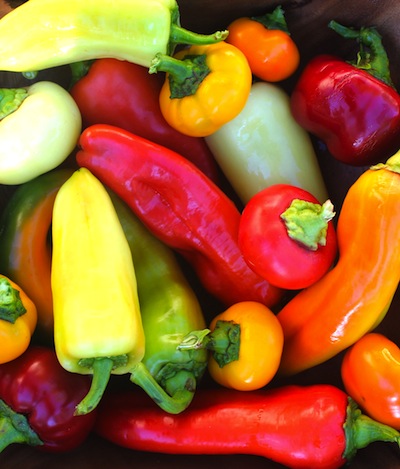 Peter Piper picked a peck of pickled peppers. I grow peppers, but never had enough to fill a peck in one harvest. And, how can someone pick pickled peppers — they aren’t pickled until after they are picked. Peppers are associated with a few suspect stories and urban legends, so let’s separate fact from fiction.
Peter Piper picked a peck of pickled peppers. I grow peppers, but never had enough to fill a peck in one harvest. And, how can someone pick pickled peppers — they aren’t pickled until after they are picked. Peppers are associated with a few suspect stories and urban legends, so let’s separate fact from fiction.
Types
Peppers are classified into eight categories … or two … or six. It all depends on who is doing the classification. Generally they are grouped based on their heat and shape. Bell peppers are the most familiar. They have a block shape, three to four lobes, and ripen red, orange or yellow. Some hybrids produce purple or chocolate colors. The green bells we most commonly see are just picked before they ripen. Bell peppers are the mildest.
Next are banana, pimento and cherry peppers. These can be mild, or have a little heat. Banana has a long tapered shape, cherry has a round shape, and pimento is small, and somewhat round.
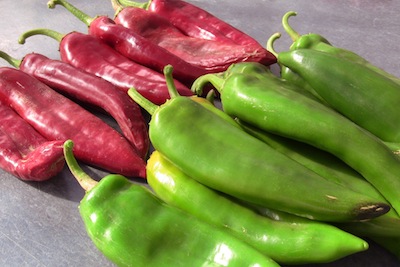
Chili peppers
Cayenne, celestial and tabasco peppers are hot. Jalapeno, pepperoncini, anaheim and chilies fall into this group. Cayenne is long and narrow, celestial is shorter, and tabasco is small and pointed.
Peppers belong to the Capsicum species and are members of the Solanaceae (nightshade) family — the same as potatoes, eggplant, tomatoes and petunias. Some of the most poisonous plants in the world are in this group.
History
Peppers are native to the Americas. Records show that chilis were grown in present day Mexico about 3500 B.C. Columbus was looking for black pepper (from the peppercorn tree) from Asia. He thought he was in India when landing in the New World and called the capsicum plant a pepper. The term is still used today, although the two peppers are unrelated.
Peppers are one of the true natives from the New World that have found their way into different cuisines all over the globe. But it was not the Spanish that spread peppers around the world — Portuguese traders did. Their trade routes brought different types of peppers to India, China, Europe and southeast Asia where cooks added them to their foods. In fact, peppers are so ingrained into some regional foods that historians initially thought peppers were native to those regions.
We consider them vegetables, but botanically speaking, peppers are classified as berries. Although they grow as annuals here in the U.S., they are perennials in Central America, Bolivia and Peru, living up to ten years. Most pepper varieties grown in North America are Capsicum annuum. Other types include C. frutescens (tabasco), C. chinense (habanero) and C. pubescens (small cherry).
Culture
Peppers like warm weather and are a long-season crop, taking 100 to 120 days to harvest from seed. They need to be started indoors from seed in late winter and transplanted outdoors after the soil has warmed in the spring. They require full sun (at least six hours a day), medium to rich fertile soil and warm temperatures of at least 70 degrees. Chili peppers grown in the Southwest are adapted to warm and dry conditions, but most peppers do not like to dry out. If the fruits are left to ripen, Vitamins A and C are increased. However, research has shown that allowing peppers to ripen slightly reduces the plant’s yield.
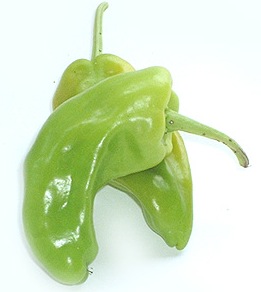
Pepperoncini
There are a few problems that can affect peppers grown here, but through my many years experience in growing them, I find them relatively problem-free. The biggest problem I find is the hot weather. The pepperoncini and especially the bell peppers discard blossoms and small fruit when the temperature stays above 80 degrees. The fruits are more abundant in late summer when temperatures begin to fall. The fruits get dark streaks in late autumn. This is a normal response to cool temperatures and is only cosmetic.
Fertilization helps the plants, but too much fertilizer causes excessive vegetative growth with little or no fruit production — a common problem for beginner gardeners who shower their plants with extra love (fertilizer).
Being in the same family, the same problems affecting tomatoes and potatoes can affect peppers. Fusarium wilt, southern blight and blossom end rot are all found on peppers, although to a lesser degree. Hybrid varieties with resistance can help keep these problems at bay.
Wilts and leaf spot are the two most troublesome diseases in home vegetable gardens. Wilts are soil-borne diseases that can cause the entire plant to wilt in normal weather. They can live in the soil for years. Avoid planting peppers and related crops (like tomatoes and potatoes) in the same spot for at least three years. Remove plant debris during winter each year to prevent overwintering diseases and pests.
Bacterial leaf spots on the leaves enlarge in warm, humid weather. They can also cause small pitting of the fruit. The disease is spread from the soil by splashing rain or irrigation. Select resistant cultivars, and avoid handling the plants when wet. Copper dust will help treat leaf spot.
Aphids and leafhoppers are the most common insect problems. These can be treated safely with insecticidal soap, neem oil or pyrethrins.
Hot Hot Hot
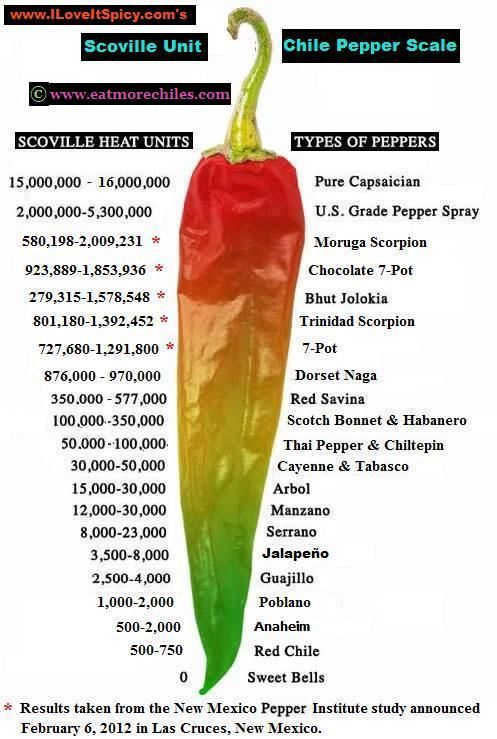 Today, hot peppers are making a mark on the culinary scene, thanks in part to the popularity of immigrant cuisine and the interest in exotic dishes. The degree of heat is determined by several types of compounds in peppers called capsaicinoids. These are not only determined by the variety of pepper, but by growing conditions — even on the same plant. Cooler weather produces milder peppers. The longer the fruit is on the plant ripening, the milder the pepper can be. The time of year, amount of daylight and temperature also affect a pepper’s heat.
Today, hot peppers are making a mark on the culinary scene, thanks in part to the popularity of immigrant cuisine and the interest in exotic dishes. The degree of heat is determined by several types of compounds in peppers called capsaicinoids. These are not only determined by the variety of pepper, but by growing conditions — even on the same plant. Cooler weather produces milder peppers. The longer the fruit is on the plant ripening, the milder the pepper can be. The time of year, amount of daylight and temperature also affect a pepper’s heat.
Capsaicin is the most common capsaicinoid. It is found in the highest concentrations on the inner tissue of the fruit where the seeds are attached, but is also found in varying degrees on other parts of the pepper. Don’t believe the tales that removing the seeds and tissue render the pepper mild and harmless.
Capsaicin is pungent to mammals, but not birds. If seeds are eaten by animals, the seeds are ground up in chewing. If eaten by birds, seeds pass through the digestive tract and can germinate later. Natural selection may have led to the development of capsaicinoids as a defense against eating by animals to favor seed dispersion by birds.
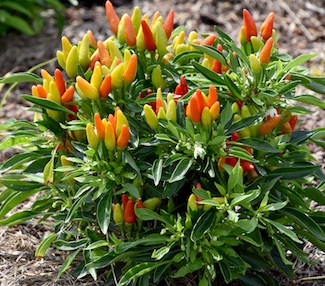
Hot ornamental pepper
Capsaicinoids can be dangerous to humans. Some people are more sensitive to these compounds and can suffer a bad reaction to them, not just by ingesting them, but by smelling or coming in contact with them. The compounds are used in repellents for deer, rodents, dogs and elephants (on crops in Africa). It is a banned substance in equestrian sports because of its hypersensitizing and pain-relieving properties on horses.
I always start peppers from seed in March. I have tried many types including ‘Black Peal’ (very hot ornamental), thai peppers (hot cooking), tri-color garda (hot ornamental) and bells. I have had the best bell pepper success with a hybrid called ‘Karma.’ I also enjoy Shishito and pepperoncini. Shishito peppers are a roll of the dice — their heat can vary widely from mild to scorching on the same plant. That’s what makes them so interesting — they are unpredictable. My pepperoncinis are prolific and are not hot. I pickle them in glass jars with salt, vinegar, garlic and pepper. But I have never pickled them by the peck.
References
Potatoes, Peppers and Eggplant, Diane Relf & Alan McDaniel, Virginia Cooperative Extension
Pepper, Robert J. Dufault & Nancy Doubrava, Clemson Cooperative Extension
Peppers, NC State Extension
Capsicum Pepper Varieties and Classification, New Mexico State University, Cooperative Extension
Integrated Pest Management in Peppers, University of Maryland Extension
A Brief History of Chili Peppers, Jodi Ettenberg, Legal Nomads